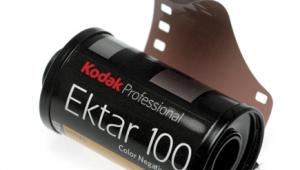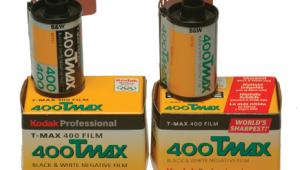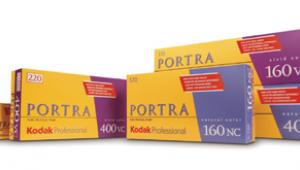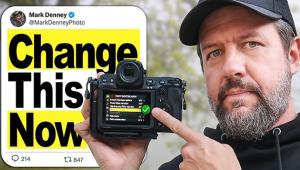Supra Film Equals Super Scans
Kodak recently released new Supra 100, 400, and 800 speed 35mm professional color negative films reported on by our Editor, Bob Shell, in the July issue. Part of the information Kodak published about these new films is that they have been formulated so they will scan better. Upon reading this I was very interested in doing scan tests of the films myself. My reason is based on quite a few years of using digital cameras and also scanning a lot of different films with most every popular scanner. This experience has taught me that digital capture has its advantages if convenience, rapid access, and the elimination of film and processing costs are important. But, film remains the best medium for image capture if you want to obtain the greatest amount of subject information recorded and reproduced, at least theoretically. |
|||
In practical terms this ideal has not been met in the past for several reasons. First, scanning film was developed primarily for the professional purposes of getting transparency images digitized for desktop publishing and printing with an offset press. Only recently has there been much development in scanner technology specifically applied to color negative film scanning. Second, color negative film images have advantages and disadvantages from a scanning perspective. One involves the dye base, the orange-brown film base color that varies from brand to brand, and even from frame to frame relative to different subject attributes that must be eliminated in the scan processing. Another is the double-edged sword of the advantage of a wider range of subject exposure values recorded in a narrower range of densities compared to chrome film making more image information available for capture by the scanner well within even a modest dynamic range. On the other hand requiring very precise translation to accurately reproduce the distinction and relationship of closely related tones in the image. |
|||
In other words, the potential information that may be captured in a color negative scan is significantly greater compared to chrome, but the challenge to scanner software processing and operator adjustment is much, much greater. So Kodak addressed these scanning problems related to color negative films in the way they formulated their new Supra professional color negative films. Scanner Testing The Kodak Supra Films. Obviously the first step in finding out if the new Kodak Supra films are better for scanning was to shoot a variety of subjects with the film and have it processed. And, to be able to determine how well these films scan, as well as how the image results compare to chrome film, required also exposing other brands of color negative film to the same subjects, for example Ektachrome 100 NC. Although all aspects of image reproduction were criteria for testing, including tone range, detail, and definition, color reproduction was my paramount concern. So, I chose subjects which would reveal the fidelity to demanding existing color palettes, including flowers and foliage, sand and surf, skin tones under diverse lighting conditions, and intense manmade colors in a rainbow of brilliant paint jobs displayed at an outdoor hot-rod car show. The test images were made with a pair of Canon EOS bodies so two different films could be exposed to the same subject using the same lens swapped back and forth. The Supra 400 and 800 films are obviously used when light levels are lower and coincidentally lighting conditions more variable, which adds a dimension to the tests complicating an evaluation of scanning because a good part of the color interpretation relates to the coloration affects of the light conditions. |
|||
Fortunately during the course of my Supra tests I had a variety of scanners to work with, including the UMAX PowerLook 1100, ArtixScan 4000t, Minolta Dimge Elite, and the new Polaroid SprintScan 45 Ultra. And, in addition to the native software provided with these scanners, I was also able to use LaserSoft SilverFast Ai with two of the scanners, as well as SilverFast HDR 5 to color correct and adjust raw high-bit scans made with the ArtixScan and the Minolta Elite. Although Kodak has released film terms for scanning and made them available for Kodak scanners on their web site, none of the scanner companies involved were able to provide software including new film terms for the Kodak Supra films. Most, I am sure will do so in future releases of their software. And, some like Minolta do not rely on film terms but rather an internal software analysis of the image attributes upon which a conversion from negative to positive is made. LaserSoft, in addition to providing some scanned film terms from which to choose, also provides an interactive on-screen dialog means to optimize the interpretation of a color negative conversion, which can be saved as a custom film term. All of these options were tested with a selection of the various images made on Supra and the control films, and all final scans were made at the maximum optical resolution of each scanner. Supra Scanning Test Results And Conclusions. Although I checked the negatives after each shoot and processing, my schedule was such that I did not get to the scanning until all of my test photography and processing was completed. So, my first task was to make proof sheets of all the film. This was done with the UMAX PowerLook 1100 flat-bed with transparency adapter, scanning an entire 36 exposure roll at a time. For all of the Kodak Supra film I chose the one generic Kodak film term provided with the UMAX software. Then using the software's eyedropper I set the shadow level by clicking on the margin between film frames, and set the highlight point using the histogram. No other adjustment was made for the final scan. The resulting proof sheets were very accurate color representations of the subjects compared to the Ektachrome slide I'd made of the same subjects. |
|||
From my proofs I selected a sample of the most promising images to scan with the dedicated film scanners I had available. First I worked with the native software with each of the scanners. These scans were reasonably successful, and the Supra film scanning demanded less adjustment to color balance, hue, and saturation than any color negative film I had scanned in the past. but compared to scanning chrome film, Supra was still demanding and more difficult to accomplish a comparable image result. I then tried scanning some of the selected images with my ArtixScan 4000t using the SilverFast Ai Photoshop plug-in. With this combination and its more sophisticated color adjustment tools I was able to improve the scan results appreciably, but it was still a labor intensive process. I also noticed that going from one subject to the next using the SilverFast color negative dialog to custom set each interpretation for conversion from negative to positive, that there was considerable variation between frames with greatly differing subject content on even a single roll. So, without specific film terms available for the Supra films, I thought maybe there is another approach to scanning these films that'll work more effectively. Taking yet another few Supra images I scanned them as if they were positive (chrome) film with the ArtixScan software set on 36-bit output. The only adjustment made to these "positive" scans was setting the dynamic range of the scan so the image information filled the gamut in the output image file saved to my hard disk. Then I opened Photoshop and started LaserSoft SilverFast HDR 5, setting the "film type" as color negative, and opened one of the scan images I just saved on my hard disk. Again I used SilverFast's color negative dialog to set the histogram points for each RGB channel to interpret the negative image. This produced a preview image that required relatively little color correction and adjustment. I then set Unsharp Masking and clicked on "Scan RGB." The final scan image that opened shortly in Photoshop's workspace looked really good. I checked the histogram, and no adjustment to Levels was required. Highlights, mid tones, and shadows were also in good balance. The color was close to ideal, and required no more tweaking than I would usually do after inputting a scan from chrome film. Encouraged and hopeful, I proceeded to scan my entire final selection from the proof sheets of images made on the Supra films in the same manner. |
|||
From this final round of Supra film scans I selected some to make prints on 13x19" paper. Compared to scans I have made in the recent past of color negative and chrome film, these scanned Kodak Supra 100 film images were superior in virtually every dimension of quality. Image detail and sharpness, fine grain, and particularly color fidelity to the subject in fully saturated, brilliant colors was exceptional. The Supra 400 and 800 were of course somewhat grainier, but even the 800 has sharp grain and preserves image detail quite well. The faster Supra films were a bit more work to obtain an ideal color adjustment, but I attribute that as much to a need to correct for the lighting conditions as anything. As I stated in the beginning, scanning 35mm color negatives when the goal is to obtain the greatest amount of image information, at a resolution sufficient to make large prints, has been theoretically the most advantageous way to then reproduce the images digitally. The Supra films bring the practical possibilities much closer to ideal yielding all of the advantages of the wide exposure latitude and lower film density range of color negative films, now scanned more easily and efficiently. I'm confident as the software for scanners is revised to include specific support for the Supra films, the advantage scanning these new Kodak films will be even easier to realize. |























































